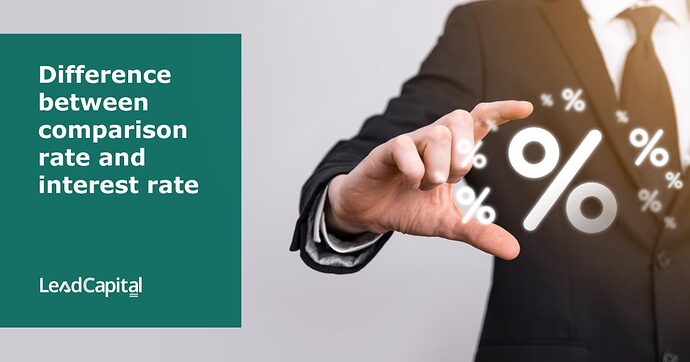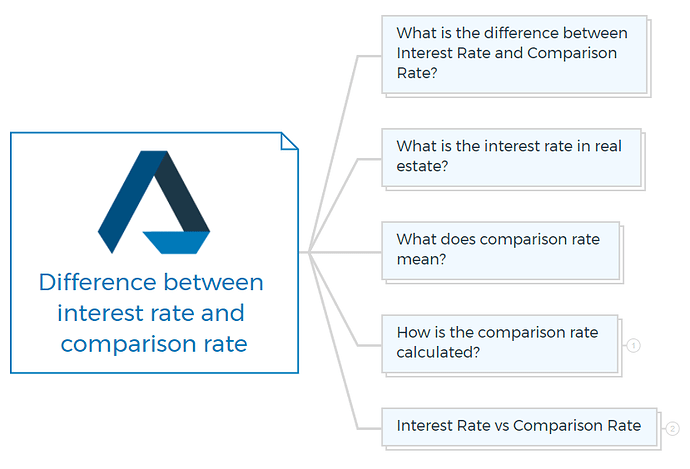What is the difference between Interest Rate and Comparison Rate?
When comparing loan products, it is vital to understand the difference between interest rates and comparison rates. Here is what you should know for getting a good deal on your mortgage.
What is the interest rate in real estate?
Interest rate, also known as a headline or advertised rate, is the rate of interest that will be added to your loan balance each year. It affects how much you will have to pay back each month.
It is simply the amount your lender will charge for borrowing money.
It is the interest a borrower pays to a lender in exchange for borrowing money. The interest rate can vary depending on the type of loan, the amount borrowed and other factors.
Interest rates are commonly expressed as an Annual Percentage Rate (APR) which shows the total cost of borrowing money over a year.
What does comparison rate mean?
The comparison rate is a single interest rate that includes the interest and all fees associated with obtaining a loan.
You can calculate it using a standard formula, so lenders do not have to display multiple interest rates on their websites or advertisements.
Comparison rates can help borrowers compare the cost of different loans more quickly by eliminating the need to calculate the interest and fees separately.
Comparison rates are always based on a $150,000 loan with a 25-year term. Since most mortgages are now bigger than that, this may not be a 100% accurate way to compare rates.
Also, many mortgages are now for 30 years or more. But the main point is that you can see how expensive a loan with a “low rate” can be.
You are missing out if you haven’t yet subscribed to our YouTube channel.
How is the comparison rate calculated?
To calculate the comparison rate, we add the interest rate on loan to any additional fees we incur. It is also expressed as a percentage of the loan balance, just like the interest rate.
Factors used in comparison rate calculations are -
- Loan term
- Loan amount
- Repayment frequency
- Interest rate
- Fees
Comparison rate example
The primary purpose of using comparison rates is to know how much a home loan will cost you. It helps the borrower to know the costs that lenders might hide by showing an inexpensive rate.
For example - Lender A gives an interest rate of 3.50% per year and a comparison rate of 3.70% per year. This means an extra 0.20% fee is added to the loan.
If another lender, say Lender B offered an interest rate of 3.40% and charged fees equal to 0.50%, your comparison rate would be 3.90%.
Lender B would seem more competitive if you only considered the interest rate. The comparison rate suggests Lender A is cheaper.
Property Development Books - “Starter-Pack”
18 Property Development Books To Get You Started Now
Includes 18 x detailed eBooks
✓ Property Development Checklist - 6 Pages
✓ How To Finance Your Property Development Project? - 13 Pages
✓ Property Development Team - 19 Pages
✓ Site Acquisition Process - 14 Pages
✓ The Ultimate Guide To Getting Started In Property Development - 42 Pages
✓ My Secret Property Development Process - 28 Pages
✓ How To Nail Your Next No Money Down Deal? - 29 Pages
✓ Industry Insiders Guide To Managing Risks In Property Development - 26 Pages
✓ How To Become A Property Developer? - 41 Pages
✓ Do You Have What It Takes To Be A Property Developer? - 12 Pages
✓ 7 Common Mistakes Made By Property Developers & How To Avoid Them? - 12 Pages
✓ 5 Reasons, Buy & Hold Property Investors Fail At Property Development - 16 Pages
✓ 10 Financial Mistakes Made By Property Investors & Developers - 54 Pages
✓ My 26 Question Due Diligence Checklist - 21 Pages
✓ Property Development 101: The Feasibility Study - 34 Pages
✓ Property Development 101: Construction Guide - 55 Pages
✓ Property Development Blueprint - 66 Pages
✓ Your Definitive Guide To Property Options - 36 Pages
Interest Rate vs Comparison Rate
Both terms are used to describe the cost of borrowing money.

Interest rate -
- Interest rate is the amount charged by a lender, usually expressed as an annual percentage, for the use of their funds.
- The interest rate depends on the loan purpose, market conditions, regulatory requirements, and the cash rate of the Reserve bank of Australia.
- This impacts your required minimum monthly payments.
Comparison rate -
- Comparison rate is a tool used to compare different loan products in terms of interest rates and fees.
- It considers the interest rate and other costs associated with a loan, such as establishment fees or ongoing fees, to present consumers with an accurate representation of the cost of borrowing money.
- The comparison rate depends on the amount borrowed, the loan term, the fees you paid throughout the loan, and the application fees.
- The interest rate of the loan is considered.
Property Finance Made Easy
We specialise in Development funding | Commercial finance | Construction loans | Portfolio refinancing & Property investment loans in Australia.
Click Here to strategise with Amber





